Themed collection Vanadium in Inorganic Chemistry

Front cover

Inside front cover

Vanadium in inorganic chemistry: excerpts from the 8th International Vanadium Symposium
Welcome to this Dalton Transactions themed issue entitled “Vanadium in Inorganic Chemistry”, with a selection of papers presented at the 8th International Vanadium Symposium.

Dalton Trans., 2013,42, 11744-11748
https://doi.org/10.1039/C3DT90107F
Catalysis science of supported vanadium oxide catalysts
Supported vanadium oxide catalysts contain a vanadium oxide phase deposited on a high surface area oxide support (e.g., Al2O3, SiO2, TiO2, etc.) and have found extensive applications as oxidation catalysts in the chemical, petroleum and environmental industries.
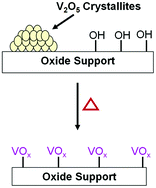
Dalton Trans., 2013,42, 11762-11769
https://doi.org/10.1039/C3DT50692D
The role of vanadium haloperoxidases in the formation of volatile brominated compounds and their impact on the environment
In this perspective we discuss the origin of bromoform in oceans and coastal waters and the role of (vanadium) haloperoxidases.

Dalton Trans., 2013,42, 11778-11786
https://doi.org/10.1039/C3DT50525A
Ion pumps as biological targets for decavanadate
E1–E2 ATPases, a family of cation pump enzymes, are known targets for specific drugs including decavanadate (V10). Decavanadate and other polyoxometalates need to cross the bilayer before targeting the ion pumps. In contrast, established organic drugs do not apparently need to cross the membrane, and probably for V10 this mechanism of action cannot be completely excluded.
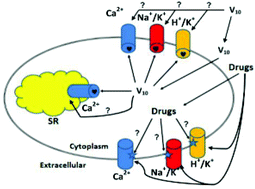
Dalton Trans., 2013,42, 11770-11777
https://doi.org/10.1039/C3DT50462J
The future of/for vanadium
Vanadium's natural role initiates the development of pro-drugs in medication, and sets off applications of ‘vanadium oxides’ in catalysis and batteries.
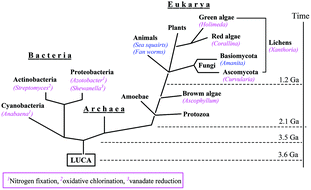
Dalton Trans., 2013,42, 11749-11761
https://doi.org/10.1039/C3DT50457C
Vanadium-catalyzed enantioselective Friedel–Crafts-type reactions
First vanadium-mediated enantioselective Friedel–Crafts (FC)-type reactions were established using the dinuclear vanadium complex.
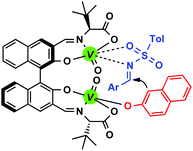
Dalton Trans., 2013,42, 11787-11790
https://doi.org/10.1039/C2DT32202A
Coordination chemistry may explain pharmacokinetics and clinical response of vanadyl sulfate in type 2 diabetic patients
Total serum vanadium is not the biologically active vanadium pool in type 2 diabetic patients orally given vanadyl sulfate.
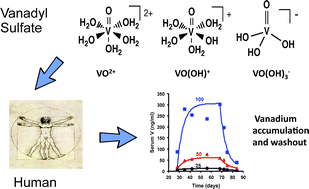
Metallomics, 2013,5, 1491-1502
https://doi.org/10.1039/C3MT00162H
Silver vanadium oxide and silver vanadium phosphorous oxide dissolution kinetics: a mechanistic study with possible impact on future ICD battery lifetimes
The kinetic results of Ag and V dissolution from silver vanadium oxide and two silver vanadium phosphorous oxides in electrolyte provide mechanistic insight towards a battery failure mode.

Dalton Trans., 2013,42, 13981-13989
https://doi.org/10.1039/C3DT51544C
Raft localization of Type I Fcε receptor and degranulation of RBL-2H3 cells exposed to decavanadate, a structural model for V2O5
Decavanadate induces raft localization of Fcε receptor and degranulation of RBL-2H3 cells upon exposure to this structural analog of V2O5.

Dalton Trans., 2013,42, 11912-11920
https://doi.org/10.1039/C3DT50398D
Discrete spherical hexadecavanadates incorporating a bromide with oxidative bromination activity
Under the oxidative bromination conditions with strong acids, discrete polyoxovanadates, [V16O38(X)]4−, were isolated.

Dalton Trans., 2013,42, 11804-11811
https://doi.org/10.1039/C3DT50521A
Vanadate-dependent bromoperoxidases from Ascophyllum nodosum in the synthesis of brominated phenols and pyrroles
In oxidation catalysis, bromoperoxidases I and II from the brown alga Ascophyllum nodosum turn over hydrogen peroxide and bromide similarly fast, providing in morpholine-4-ethanesulfonic acid (MES)-buffered aqueous tert-butanol (pH 6.2) molecular bromine as reagent for electrophilic hydrocarbon bromination.

Dalton Trans., 2013,42, 11926-11940
https://doi.org/10.1039/C3DT51582F
Vanadium(IV/V)–p-dioxolene temperature induced electron transfer associated with ligation/deligation of solvent molecules
Temperature dependent electron transfer of a VV/IV–p-dioxolene system associated with an interconversion of the vanadium coordination sphere from trigonal bipyramidal to octahedral.
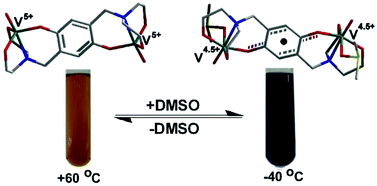
Dalton Trans., 2013,42, 11831-11840
https://doi.org/10.1039/C3DT50619C
Preliminary anti-cancer photodynamic therapeutic in vitro studies with mixed-metal binuclear ruthenium(II)–vanadium(IV) complexes
Photodynamic therapeutic studies are reported with ruthenium(II)–vanadium(IV) complexes.
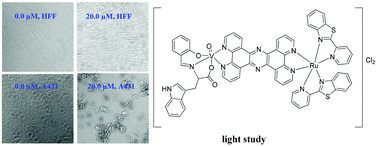
Dalton Trans., 2013,42, 11881-11899
https://doi.org/10.1039/C3DT50547B
A new series of heteroleptic oxidovanadium(IV) compounds with phenanthroline -derived co-ligands : selective Trypanosoma cruzi growth inhibitors
Novel vanadium complexes showed high activity and selectivity towards Trypanosoma cruzi.
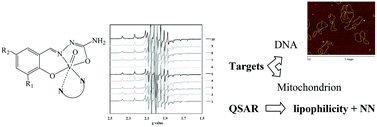
Dalton Trans., 2013,42, 11900-11911
https://doi.org/10.1039/C3DT50512J
Antitumor properties of a vanadyl(IV) complex with the flavonoid chrysin [VO(chrysin)2EtOH]2 in a human osteosarcoma model: the role of oxidative stress and apoptosis
Antitumor properties of a vanadium(IV) complex with chrysin were evaluated in MG-63 osteosarcoma cells, studied by cyto-, genotoxicity and apoptosis.
![Graphical abstract: Antitumor properties of a vanadyl(iv) complex with the flavonoid chrysin [VO(chrysin)2EtOH]2 in a human osteosarcoma model: the role of oxidative stress and apoptosis](/en/Image/Get?imageInfo.ImageType=GA&imageInfo.ImageIdentifier.ManuscriptID=C3DT50524C&imageInfo.ImageIdentifier.Year=2013)
Dalton Trans., 2013,42, 11868-11880
https://doi.org/10.1039/C3DT50524C
A sustainable two-phase procedure for V-catalyzed toluene oxidative bromination with H2O2–KBr
Efficient V(v) and Mo(VI) catalysed two-phase bromination of toluene is reported with H2O2 as primary oxidant and KBr as brominating intermediates source. Recycling of the catalytic phase is possible. Useful information on the V-peroxido chemistry was obtained.

Dalton Trans., 2013,42, 11963-11970
https://doi.org/10.1039/C3DT50907A
Chiral vanadium(V) complexes with 2-aminoglucose Schiff-base ligands and their solution configurations: synthesis, structures, and DFT calculations
For oxidovanadium complexes with chiral ligands the configuration of the diastereomers has been unambiguously assigned in solution and solid state.
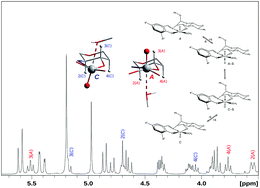
Dalton Trans., 2013,42, 11812-11823
https://doi.org/10.1039/C3DT50890K
The vanadyl chelate bis(acetylacetonato)oxovanadium(IV) increases the fractional uptake of 2-(fluorine-18)-2-deoxy-D-glucose by cultured human breast carcinoma cells
Treatment of mice with bis(acetylacetonato)oxovanadium(IV) prior to PET imaging enhances preferential uptake of FDG into malignant tissue by several-fold.
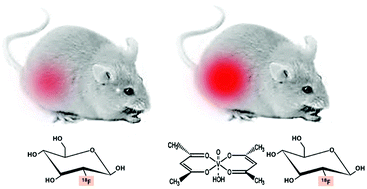
Dalton Trans., 2013,42, 11862-11867
https://doi.org/10.1039/C3DT50549A
Metal ion selectivity of the vanadium(V)-reductase Vanabin2
The high selectivity of the V(V)-reductase, Vanabin2, may account for the metal ion selectivity of vanadium accumulation in ascidians.
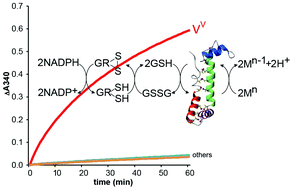
Dalton Trans., 2013,42, 11921-11925
https://doi.org/10.1039/C3DT50404B
A novel VIVO–pyrimidinone complex: synthesis, solution speciation and human serum protein binding
A new pyrimidinone is synthesized and the binding of its VIVO2+ complexes with serum proteins is reported.
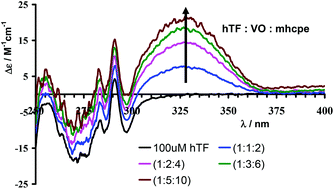
Dalton Trans., 2013,42, 11841-11861
https://doi.org/10.1039/C3DT50553G
Synthesis of vanadium(V) hydrazido complexes with tris(2-hydroxyphenyl)amine ligands
The vanadium(V) hydrazido complexes with the tris(2-hydroxyphenyl)amine ligands were designed to reveal the influence of the coordination from the apical nitrogen and the substituent of the tris(2-hydroxyphenyl)amine moiety on the vanadium center.
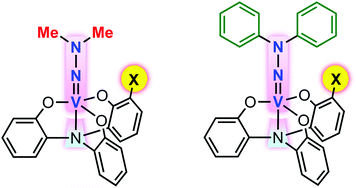
Dalton Trans., 2013,42, 11824-11830
https://doi.org/10.1039/C3DT50533B
Vanadium complexes having [VO]2+, [VO]3+ and [VO2]+ cores with hydrazones of 2,6-diformyl-4-methylphenol: synthesis, characterization, reactivity, and catalytic potential
[VO]2+-, [VO]3+- and [VO2]+-complexes with hydrazones of 2,6-diformyl-4-methylphenol were isolated and used as functional models of vanadium dependent haloperoxidases.
![Graphical abstract: Vanadium complexes having [VO]2+, [VO]3+ and [VO2]+ cores with hydrazones of 2,6-diformyl-4-methylphenol: synthesis, characterization, reactivity, and catalytic potential](/en/Image/Get?imageInfo.ImageType=GA&imageInfo.ImageIdentifier.ManuscriptID=C3DT50469G&imageInfo.ImageIdentifier.Year=2013)
Dalton Trans., 2013,42, 11941-11962
https://doi.org/10.1039/C3DT50469G
A new binuclear oxovanadium(V) complex as a catalyst in combination with pyrazinecarboxylic acid (PCA ) for efficient alkane oxygenation by H2O2
A new catalytic system based on V(V) and PCA for the oxidation of alkanes is described.
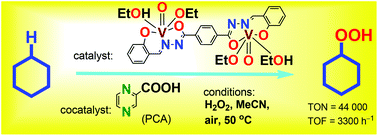
Dalton Trans., 2013,42, 11791-11803
https://doi.org/10.1039/C3DT50584G
About this collection
This themed issue, guest edited by Professors Debbie Crans and Craig McLauchlan, contains a selection of articles from leading researchers working in the area of vanadium chemistry, including participants of the 8th International Symposium on Vanadium.